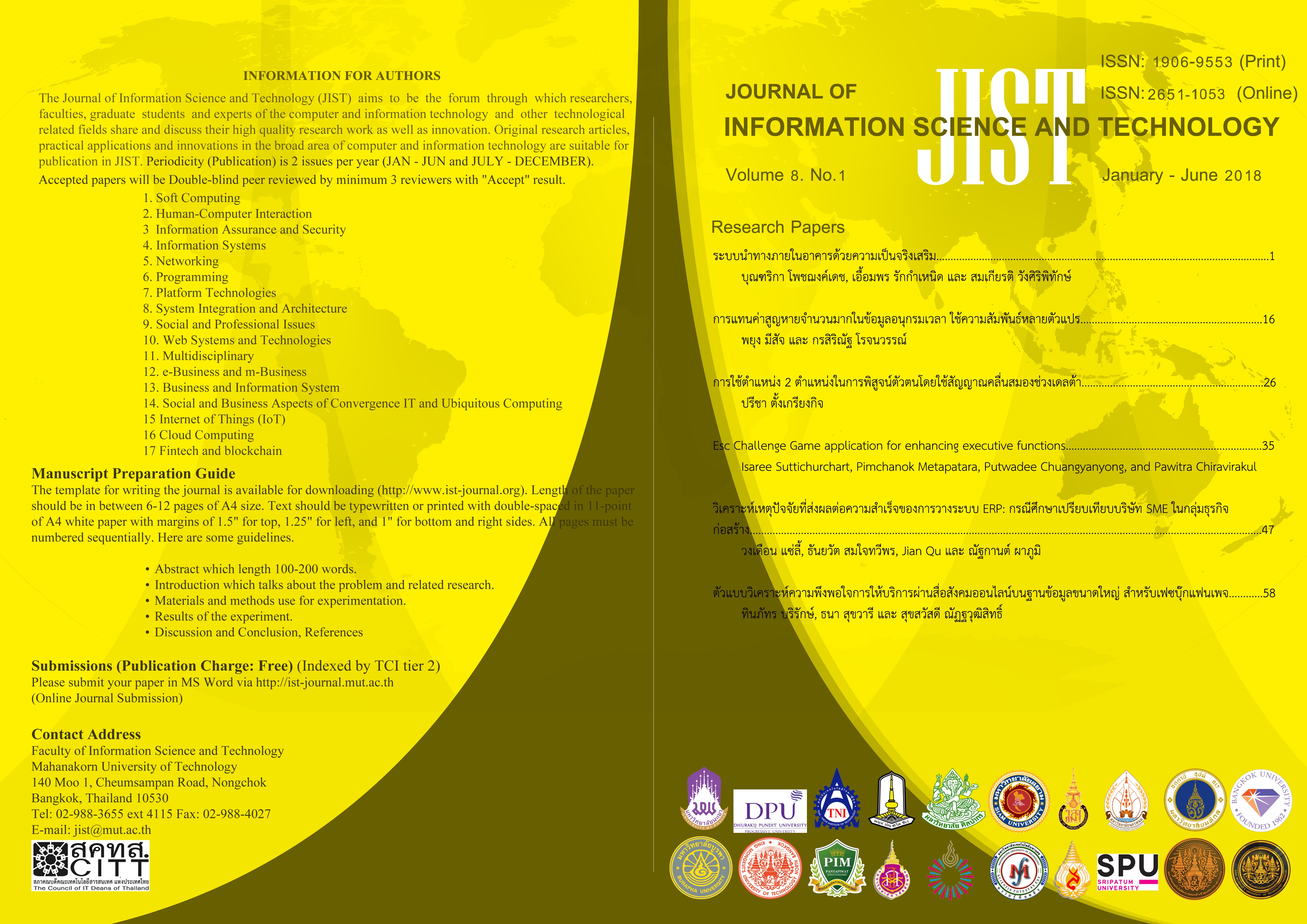Social Service Satisfaction Analytic Model On Big Data for Facebook Fanpage
Main Article Content
Abstract
- The objective of this research is to develop a model of satisfaction analysis on service system. This research focuses on identifying which service systems have low levels of customer satisfaction. This reflects the fact that the service system is experiencing problems with the service. This research has used Facebook as a source of information to express dissatisfaction with the service. By manipulating, the data from Facebook's unstructured data into a structured form called a frame, before processing the satisfaction model with Linear Combination. The results showed that the accuracy of the model was 87.50%, which is satisfactory.
Article Details
This work is licensed under a Creative Commons Attribution-NonCommercial-NoDerivatives 4.0 International License.
I/we certify that I/we have participated sufficiently in the intellectual content, conception and design of this work or the analysis and interpretation of the data (when applicable), as well as the writing of the manuscript, to take public responsibility for it and have agreed to have my/our name listed as a contributor. I/we believe the manuscript represents valid work. Neither this manuscript nor one with substantially similar content under my/our authorship has been published or is being considered for publication elsewhere, except as described in the covering letter. I/we certify that all the data collected during the study is presented in this manuscript and no data from the study has been or will be published separately. I/we attest that, if requested by the editors, I/we will provide the data/information or will cooperate fully in obtaining and providing the data/information on which the manuscript is based, for examination by the editors or their assignees. Financial interests, direct or indirect, that exist or may be perceived to exist for individual contributors in connection with the content of this paper have been disclosed in the cover letter. Sources of outside support of the project are named in the cover letter.
I/We hereby transfer(s), assign(s), or otherwise convey(s) all copyright ownership, including any and all rights incidental thereto, exclusively to the Journal, in the event that such work is published by the Journal. The Journal shall own the work, including 1) copyright; 2) the right to grant permission to republish the article in whole or in part, with or without fee; 3) the right to produce preprints or reprints and translate into languages other than English for sale or free distribution; and 4) the right to republish the work in a collection of articles in any other mechanical or electronic format.
We give the rights to the corresponding author to make necessary changes as per the request of the journal, do the rest of the correspondence on our behalf and he/she will act as the guarantor for the manuscript on our behalf.
All persons who have made substantial contributions to the work reported in the manuscript, but who are not contributors, are named in the Acknowledgment and have given me/us their written permission to be named. If I/we do not include an Acknowledgment that means I/we have not received substantial contributions from non-contributors and no contributor has been omitted.
References
2. S. L. Addepalli, S. G. Addepalli, M. Kherajani, H. Jeshnani, and S. Khedkar, “A Proposed Framework for Measuring Customer Satisfaction and Product Recommendation for Ecommerce,” International Journal of Computer Applications, vol. 138, no. 3, pp. 30-35, 2016.
3. A. Parasuraman, V. A. Zeithaml, and L. L. Berry, “SERVQUAL: A Multiple-Item Scale for Measuring Consumer Perceptions of Service Quality,” Journal of Retailing, vol. 64, no. 1, pp. 12-40, 1988.
4. P. Kotler, Marketing Management: The Millennium Edition, 10th ed., NJ: Prentice Hall, 2000.
5. ธีรวัฒน์ นาคะบุตร, ตัวแบบเชิงคณิตศาสตร์, ครั้งที่ 1, นครปฐม: คณะวิทยาศาสตร์และเทคโนโลยี มหาวิทยาลัยราชภัฏนครปฐม, 2546.
6. D. Cherney, T. Denton, R. Thomas, and A. Waldron, Linear Algebra, 1st ed., CA: Davis, 2013.
7. K. Kuttler, Linear Algebra, Theory and Applications, Reading, Washington D.C: Saylor, 2012. [E-book] Available: Chrome e-book.
8. T. Sukvaree, A. Kawtrakul, and J. Caelen. “Thai text Coherence Structuring with Coordinating and Subordinating Relations for Text Summarization.” In Proc. International and Interdisciplinary Conference on Modeling and using Context (CONTEXT 2007), pp. 453-466, 2007.
9. A. Faed, O. K. Hussain, and E. Chang. “A methodology to map customer complaints and measure customer satisfaction and loyalty,” Service Oriented Computing and Applications, vol. 8, no. 1, pp. 33-53, 2014.
10. S. M. Lin, “Analysis of Service Satisfaction in Web Auction Logistics Service Using a Combination of Fruit fly Optimization Algorithm and General Regression Neural Network,” Neural Computing and Applications, vol. 22, no. 4, pp. 783-791, 2013.


